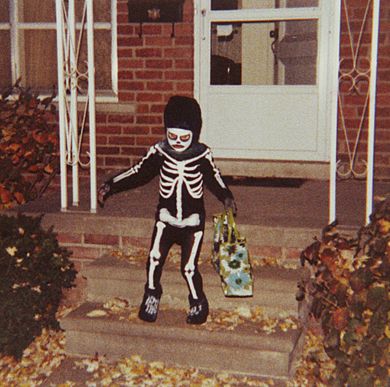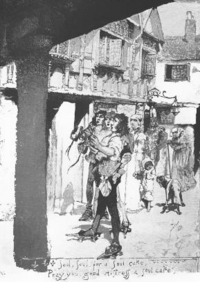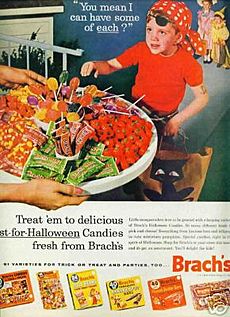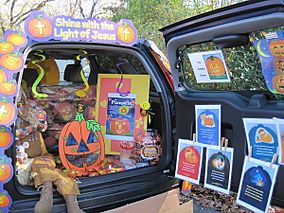Trick-or-treating facts for kids
Trick-or-treating is a fun Halloween tradition for kids and grown-ups in many countries. On the evening of October 31, people wear costumes and visit houses. They ask for treats by saying, "trick or treat!"
The "treat" is usually candy or sweets. Sometimes, people even give out money. The "trick" is a playful threat to cause a little mischief if no treat is given. It's usually just for fun! Many homes show they are ready for trick-or-treaters by putting up Halloween decorations. Some also leave their porch lights on. This is a common sign that they have candy to share.
This tradition started a long time ago in Scotland and Ireland. There, it was called guising. Children would go from house to house in costumes. They would perform a small show, like singing a song, to get food or treats. People have been wearing costumes for Halloween since at least the 1500s. In North America, children started guising around 1911 in Ontario, Canada. The phrase "trick or treat!" was first heard there in 1917. While guising has been popular for a long time in Scotland and Ireland, saying "trick or treat" only became common there in the 2000s. Before that, Irish children often said, "help the Halloween party".
Trick-or-treating is very popular in the United Kingdom, Ireland, the United States, Canada, and Australia. It has also spread to Mexico. In parts of Mexico, it's called calaverita. Children ask, "¿Me da mi calaverita?" which means "Can you give me my little skull?" A calaverita is a small skull made of sugar or chocolate.
Contents
The History of Trick-or-Treating
Early Traditions
Some traditions similar to trick-or-treating go back to ancient times. For example, in ancient Greece, children on the island of Rhodes would dress as swallows. They sang a song at people's doors, asking for food. If they didn't get food, they would playfully threaten to cause trouble.
Souling and Spirits
Since the Middle Ages, people in Britain and Ireland had a tradition called mumming. They would go door-to-door in costumes, acting out short plays for food or drinks. Trick-or-treating on Halloween might come from an old belief. People thought that spirits or the souls of the dead roamed the Earth around Halloween. They needed to be made happy with offerings.
Another idea is that it came from a Celtic festival called Samhain. This festival was held on October 31 and November 1. It marked the start of winter in Ireland, Scotland, and the Isle of Man. People believed that spirits and the souls of the dead could visit our world then. They would leave food and drinks to welcome them. Some think trick-or-treating grew from people pretending to be these spirits or souls. They would get offerings on their behalf. This was also believed to protect people from the spirits.
Around the 1400s, Christians started sharing soul-cakes during Allhallowtide (October 31 to November 2). People would visit houses and take soul-cakes. They might do this as representatives of the dead. Or they would get cakes in return for praying for the souls of the dead. This was known as 'Souling'. It happened in parts of Britain and other European countries. People would sing under windows, asking for "mercy on all Christian souls for a soul-cake."
Guising: Dressing Up for Treats
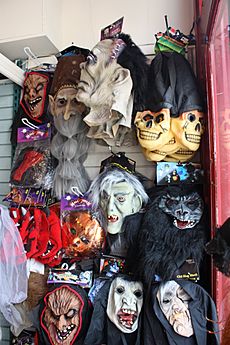
In Scotland and Ireland, "guising" is a popular tradition. Children go door-to-door in costumes. They receive gifts like food, coins, or "apples or nuts for the Halloween party." Today, they often get chocolate. It's called "guising" because of the disguises or costumes they wear. In Scotland, young people would go house to house in white clothes. They had masked, painted, or blackened faces. They would say rhymes and sometimes playfully threaten mischief if they weren't welcomed.
Guising has been recorded in Scotland since the 1500s. An old record from 1895 describes guisers in Scotland. They carried lanterns made from hollowed-out turnips. They visited homes to get cakes, fruit, and money. In Ireland, children in costumes would often say, "Help the Halloween Party" at people's doors.
Halloween masks are called "false faces" in Ireland and Scotland. In the 1950s, a child in Ardrossan, Scotland, received a good amount of money for guising. When growing up in Derry, Northern Ireland, in the 1960s, a journalist remembered children asking, "Any nuts or apples?" In Scotland and Ireland, children are supposed to perform a trick to get treats. This is usually singing a song or telling a joke or poem they have learned.
Trick-or-Treating Comes to North America
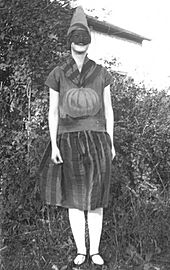
The first time guising was recorded in North America was in 1911. A newspaper in Kingston, Ontario, Canada, wrote about children going "guising" in their neighborhood.
An American writer named Ruth Edna Kelley wrote a book about Halloween in 1919. She mentioned old traditions like souling. She noted that American Halloween customs came from other countries. She said Americans were making Halloween like it was in its best days overseas.
The phrase "Trick or treat!" started to appear in central Canada. Then it spread to the northern and western United States in the 1930s. By the 1940s and early 1950s, it was common across the U.S. The first known use of "Tricks or treats" was in 1917 in Sault Ste. Marie, Ontario. Children would call out, "Tricks or treats!" If the homeowner gave them a "coin" for "treats," their house was safe from pranks.
Many Halloween postcards from the early 1900s don't show trick-or-treating. It seems the practice didn't become widespread until the 1930s. The term first appeared in a U.S. publication in 1932.
Before the 1930s, similar begging activities were more common on Thanksgiving. In New York City, children dressed as beggars and asked for treats. This was called Ragamuffin Day. Over time, the begging part stopped, and the tradition ended by the 1950s.
Growing Popularity
Almost all mentions of "trick-or-treat" before 1940 are from the United States and Canada. Trick-or-treating spread across the U.S. It only slowed down during World War II because of sugar rationing. This rationing lasted from 1942 to 1947.
Trick-or-treating gained national attention in 1947 in children's magazines. It was also featured on radio shows like The Baby Snooks Show in 1946 and The Jack Benny Show in 1948. The Peanuts comic strip showed trick-or-treating in 1951. By 1952, it was a big part of popular culture. Walt Disney showed it in his cartoon Trick or Treat. In 1953, UNICEF started its "Trick-or-Treat for UNICEF" campaign. Children could collect money for charity while trick-or-treating.
"Trick or Treat" in the UK and Ireland
Even though the idea of trick-or-treating came from Britain and Ireland, the phrase "trick or treat" wasn't common there until the 1980s. Movies like E.T. helped make it popular. Guising usually involves performing a song or poem without any threats. In the 1980s, "trick or treat" was sometimes seen as a new, not-so-welcome idea. In Ireland, before "trick or treat" became common, children would say "Help the Halloween Party". Today, people often just say "trick or treat" and get sweets. The choice of a trick or a treat is often skipped.
Trick-or-Treating Rules
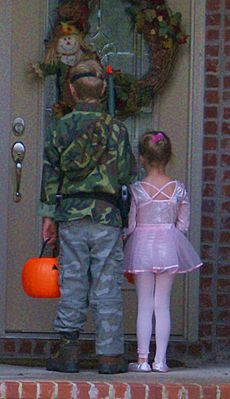
Trick-or-treating usually starts at sunset on October 31. Some towns might choose different dates. Homeowners who want to give out treats often decorate their homes. They might use fake spider webs, plastic skeletons, and jack-o-lanterns. If people don't want to participate, they might turn off their outside lights or close their gates.
In most places, trick-or-treating is for children. Some areas in the United States don't allow anyone over 12 to trick-or-treat. However, people of all ages enjoy dressing up. Adults often dress up to go with their children. Young adults might dress up to collect donations for charity.
Different Ways to Trick-or-Treat
In the U.S. and Canada
In St. Louis, Missouri, children often tell a joke, like a simple Halloween riddle, before getting candy. This "trick" earns the "treat." Children in Des Moines, Iowa, also tell jokes or perform.
In some parts of Canada, children might say "Halloween apples" instead of "trick or treat." This probably started when toffee apples were popular treats. However, giving out apples became less common after the 1960s. There were stories, likely untrue, about razors hidden inside Halloween apples. Parents started checking fruit for safety. In Quebec, children also go door-to-door. In French-speaking areas, they simply say "Halloween." Traditionally, they used to say "La charité, s'il-vous-plaît" ("Charity, please").
Trunk-or-Treat Events
Some groups in the United States and Canada hold "trunk-or-treat" events. These happen on Halloween night or a nearby weekend. People park their cars in a parking lot, often at a school or church. They open their car trunks, which are decorated and filled with candy. They might also have games. Some parents think trunk-or-treating is a safer way to get candy. Others find it easier than walking around the neighborhood.
This event started in the mid-1990s as a "fall festival." It became known as "trunk-or-treat" about 20 years later. By 2006, these events were becoming very popular.
In Portugal and Spain
In Portugal, children go house-to-house on All Saints Day and All Souls Day. They carry pumpkin lanterns called coca. They ask for Pão-por-Deus (bread for God) and sing rhymes. The rhymes remind people why they are begging. For example, they might say, "...It is for me and for you, and to give to the deceased who are dead and buried." This tradition has been recorded since the 1400s. In Galicia, Spain, children ask for "a little charity for the little deceased who are there." They usually get bread, sweets, fruits, chestnuts, money, or small toys.
In Sweden, children dress as witches and monsters for trick-or-treating on Maundy Thursday (the Thursday before Easter). In Denmark, children dress up and go trick-or-treating on Fastelavn (the day before Lent). In Norway, children often dress up and ask for candy. In Finland, the Easter witch tradition happens on Palm Sunday.
In Other Parts of Europe
In parts of Flanders, the Netherlands, and most of Germany, Switzerland, and Austria, children visit houses with homemade beet or paper lanterns. They sing songs about St. Martin on St. Martin's Day (November 11). In return, they get treats. The German phrase for "trick-or-treat" is "Süßes oder Saures," meaning "sweets or sours."
In Northern Germany and Southern Denmark, children dress in costumes and go trick-or-treating on New Year's Eve. This tradition is called "Rummelpott [de]".
Trick-or-Treating for Charity
UNICEF started a program in 1950 called Trick-or-Treat for UNICEF. In this program, trick-or-treaters ask people for money for the organization instead of candy. Children say, "Trick-or-treat for UNICEF!" when they knock on doors. UNICEF provides special collection boxes. These boxes explain how the money helps children in developing countries.
In Canada, high school and college students sometimes dress up to collect food donations for local Food Banks. This is a form of trick-or-treating and is sometimes called "Trick-or-Eat."
See also


